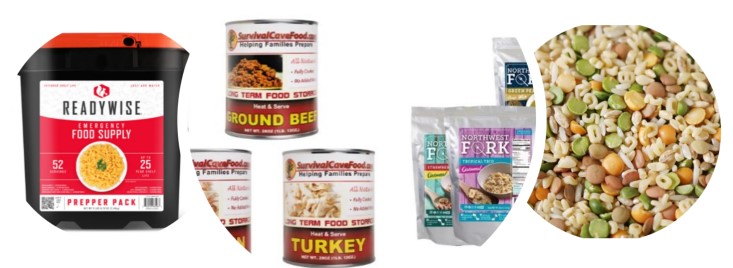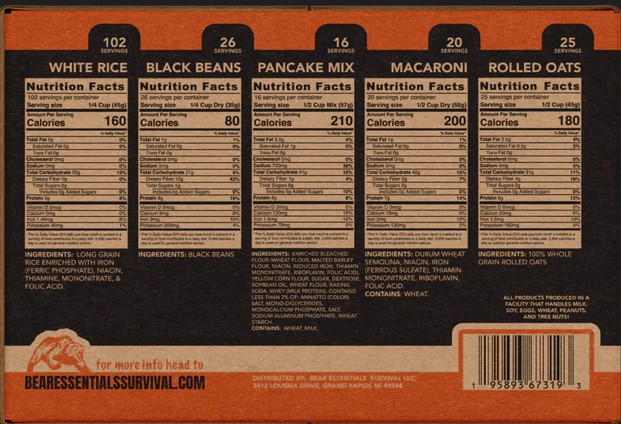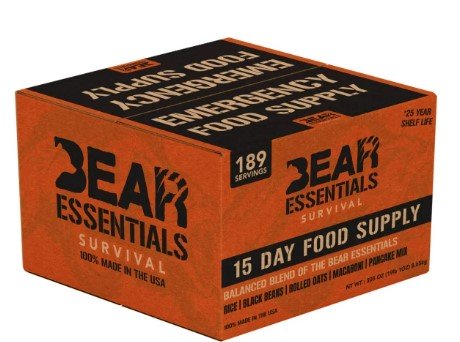Survival Food Supply Reviews From The Perspective Of An Organic Farmer
 I grow and store a LOT of food, but I can't grow everything I grow and store a LOT of food, but I can't grow everythingMan, the world seems to be getting crazier every day! And being prepared is the only rational response to the crazoids. I've written elsewhere that, in an emergency Job #1 is to feed yourself and your family. As an organic farmer I'm firmly rooted in the belief that the best survival food supply is what you can grow for yourself. I wrote Bootstrap Survival Garden to encourage others to maximize their home-grown calories. I have a big garden, 3 greenhouses, 4 freezers, a cold storage room, and I have home-canned everything from string beans to salmon. When my laying hens have reached the end of their productive life, into the jar they go! However, even an experienced grower can recognize there are situations where relying on store-bought stored provisions is not just a convenience but a necessity. So, welcome to the first installment of my series 'Survival Food Supply Reviews,' where I delve into the world of survival sustenance from the perspective of an earth-conscious farmer. Ensuring adequate calories to sustain life is only one part of emergency preparedness, but it's a BIG part. Let's get to it! My Approach To These Reviews
 Calories are important but so is nutrition Calories are important but so is nutritionThe variety and quality of survival foods has really grown in the last few years. This is good news for preppers, but tough on us reviewers. It would be impossible for me to review every box, bucket and big can on the market, so I'm going to curate a selection that I think have the most to offer for your dollar. I'll be drawing on the experience of seasoned growers and survivalists, and investigating some of the highest-rated survival food kits and companies. My goal is to tap into the collective knowledge of those who have weathered challenges and cultivated resilience in the face of adversity and curate that experience for your benefit. I expect to learn a few things my own self, along the way. What I'll Cover in These Reviews
My survival food supply reviews will cover the features I think are most relevant to the prospective purchaser. Here's the short list, from the outside-in. Packaging. Packaging is not just a pretty wrapper; it's what should protect your emergency food supply against time and the elements. I'll identify packaging methods, and the circumstances where they are appropriate. From cans to buckets to foil pouches, I'll review the packaging innovations that ensure your emergency food supply is intact when you need it. Nutrition. The nutritional value derived from organic, home-grown produce can't be beat by any store-bought product. Even store-bought fresh is cheaper and more nutritious than any canned good. That said, there are worse and better choices for your long-term food supply. Calories are important, but beyond mere sustenance, my reviews will look at the nutrient content of chosen emergency kits. How do they stack up with respect to essential vitamins and minerals? Can they provide a reasonably balanced diet to sustain you through challenging times? Read along with me in uncovering the nutritional value of the survival food supplies that might be your lifeline in critical situations. Shelf Life. One of the pillars of emergency preparedness is the shelf life of your stored provisions. From canning to dehydration to freeze-drying, I'll review the methods employed to extend the shelf life of emergency food supplies. Cost Efficiency. While investing in your own survival garden is an ideal path, sometimes you gotta drop some coin to prepare for an emergency. In this series, I'll break down the cost factor of some popular emergency food supplies. Where do you get value for your money? Is the investment in this pre-packaged provision justified? Join me as we explore the cost efficiency of emergency food kits and assess their viability in the context of long-term survival planning. And finally, taste. Taste matters, even in times of crisis. My reviews will include an exploration of the palatability of emergency food supplies. I lean towards supplies that can be used to make a bunch of different dishes, but I'll also review some pre-packaged 'meal kit' offerings that rank high on the tasty list. My Survival Food Supply Reviews Will Be An On-Going Series
I'm an organic farmer, and over the past 20+ years here on New Terra Farm, I've come to a deep appreciation for the earth's bounty. But I embark on this series with the conviction that emergency food kits can complement a self-sustained survival strategy. While homegrown crops form the backbone of a resilient food supply, there's room for well-crafted emergency provisions. To draw an analogy, diversity is the heartbeat of a thriving ecosystem, and it's no different when building your emergency food supply. My reviews will encompass an array of the options available, including vegetarian and vegan choices and those catering to specific dietary needs. I'll also look at particular segments of the market like the best canned food for survival and - of course - the best organic survival food options. My Survival Food Supply Reviews
 Bear Essentials Survival 15-Day Food Supply Bear Essentials Survival 15-Day Food SupplyBear Essentials Survival is a Michigan-based, veteran-owned small business established in 2020. All their products are made in the USA, with a shelf-life of up to 25 years. They take a little different approach to survival food supplies, providing basic staples like beans, rice, pasta and rolled oats that can provide a pretty complete diet and also supplement the goodies from your garden. Learn more in my review of their 15-Day Emergency Food Supply Box. |
- Home
- Cheap Survival Food
- Survival Food Supply Reviews